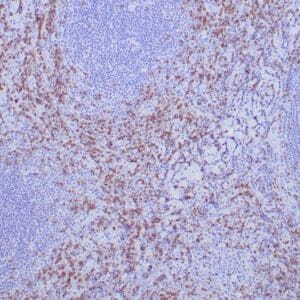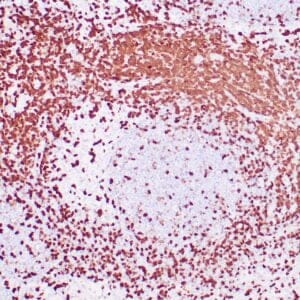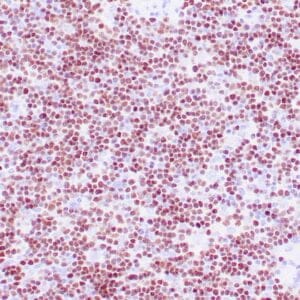| Weight | 1 lbs |
|---|---|
| Dimensions | 9 × 5 × 2 in |
| host | mouse |
| isotype | IgG1/K |
| clonality | monoclonal |
| concentration | concentrate, predilute |
| applications | IHC |
| reactivity | human |
| available size | 0.1 mL, 0.5 mL, 1 mL concentrated, 7 mL prediluted |
mouse anti-CD79a monoclonal antibody (JCB117) 6113
Price range: $160.00 through $528.00
Antibody summary
- Mouse monoclonal to CD79a
- Suitable for: Immunohistochemistry (formalin-fixed, paraffin-embedded tissues)
- Reacts with: Human
- Isotype:IgG1/K
- Control: Tonsil or lymph node
- Visualization: Membrane
- 0.1, 0.5, 1.0 mL concentrated, 7 mL prediluted
mouse anti-CD79a monoclonal antibody JCB117 6113
| target relevance |
|---|
| Protein names B-cell antigen receptor complex-associated protein alpha chain (Ig-alpha) (MB-1 membrane glycoprotein) (Membrane-bound immunoglobulin-associated protein) (Surface IgM-associated protein) (CD antigen CD79a) |
| Gene names CD79A,CD79A IGA MB1 |
| Mass 25038Da |
| Function FUNCTION: Required in cooperation with CD79B for initiation of the signal transduction cascade activated by binding of antigen to the B-cell antigen receptor complex (BCR) which leads to internalization of the complex, trafficking to late endosomes and antigen presentation. Also required for BCR surface expression and for efficient differentiation of pro- and pre-B-cells. Stimulates SYK autophosphorylation and activation. Binds to BLNK, bringing BLNK into proximity with SYK and allowing SYK to phosphorylate BLNK. Also interacts with and increases activity of some Src-family tyrosine kinases. Represses BCR signaling during development of immature B-cells. {ECO:0000269|PubMed:8617796, ECO:0000269|PubMed:9057631}. |
| Subellular location SUBCELLULAR LOCATION: Cell membrane; Single-pass type I membrane protein. Note=Following antigen binding, the BCR has been shown to translocate from detergent-soluble regions of the cell membrane to lipid rafts although signal transduction through the complex can also occur outside lipid rafts. {ECO:0000250}. |
| Tissues TISSUE SPECIFICITY: B-cells. |
| Structure SUBUNIT: Heterodimer of alpha and beta chains; disulfide-linked. Part of the B-cell antigen receptor complex where the alpha/beta chain heterodimer is non-covalently associated with an antigen-specific membrane-bound surface immunoglobulin of two heavy chains and two light chains (PubMed:35981043). Interacts through its phosphorylated ITAM domain with the SH2 domains of SYK which stimulates SYK autophosphorylation and activation. Also interacts, when phosphorylated on Tyr-210, with the SH2 domain of BLNK/SLP65, bringing BLNK into proximity with SYK and allowing SYK to phosphorylate BLNK which is necessary for trafficking of the BCR to late endosomes. Interacts with Src-family tyrosine kinases including FYN and LYN, increasing their activity (By similarity). {ECO:0000250, ECO:0000269|PubMed:35981043}. |
| Post-translational modification PTM: Phosphorylated on tyrosine, serine and threonine residues upon B-cell activation. Phosphorylation of tyrosine residues by Src-family kinases is an early and essential feature of the BCR signaling cascade. The phosphorylated tyrosines serve as docking sites for SH2-domain containing kinases, leading to their activation which in turn leads to phosphorylation of downstream targets. Phosphorylated by LYN. Phosphorylation of serine and threonine residues may prevent subsequent tyrosine phosphorylation. {ECO:0000269|PubMed:10748115, ECO:0000269|PubMed:10900006}.; PTM: Arginine methylation in the ITAM domain may interfere with the binding of SYK. It promotes signals leading to B-cell differentiation (By similarity). {ECO:0000250}. |
| Domain DOMAIN: The transmembrane helices of CD79A and CD79B chains and two IgM heavy chains assembly in a four-helix bundle structure that appears to be conserved among different BCR isotypes. {ECO:0000269|PubMed:35981043}. |
| Involvement in disease DISEASE: Agammaglobulinemia 3, autosomal recessive (AGM3) [MIM:613501]: A primary immunodeficiency characterized by profoundly low or absent serum antibodies and low or absent circulating B-cells due to an early block of B-cell development. Affected individuals develop severe infections in the first years of life. {ECO:0000269|PubMed:10525050, ECO:0000269|PubMed:11920841}. Note=The disease is caused by variants affecting the gene represented in this entry. Two different mutations, one at the splice donor site of intron 2 and the other at the splice acceptor site for exon 3, have been identified. Both mutations give rise to a truncated protein. |
| Target Relevance information above includes information from UniProt accession: P11912 |
| The UniProt Consortium |
Data
 |
| Human tonsil stained with anti-CD79a antibody using peroxidase-conjugate and DAB chromogen. Note the cytoplasmic staining of follicular center and parafollicular B-cells. |
Publications
| pmid | title | authors | citation |
|---|---|---|---|
| We haven't added any publications to our database yet. | |||
Protocols
| relevant to this product |
|---|
| IHC |
Documents
| # | SDS | Certificate | |
|---|---|---|---|
| Please enter your product and batch number here to retrieve product datasheet, SDS, and QC information. | |||
Only logged in customers who have purchased this product may leave a review.















Reviews
There are no reviews yet.